
I can’t remember how many Tajik weddings I have attended, and I still enjoy it, because Tajik weddings are interesting and humane. All the people in the village will be dressed up to attend, there will be no lengthy nonsense by the host, no huge expenses, no unpalatable banquets, only non-stop singing and dancing, eagle flutes and tambourines, mutton and pilaf, and sincere smiling faces under the snow-capped mountains.

The Tajik people living in the Pamirs are completely beyond my imagination. They maintain their original state, and their ancestors have been carved out of the same mold for generations, just like how rivers should flow and white clouds should float like this.

This time, I followed the bridegroom’s family to meet the bride in Waqia Township, 50 kilometers away from the county seat. The night before, the two families will treat guests at their own homes, relatives, friends, neighbors and folks will come, and there will be no shortage of killing sheep and dancing. At noon the next day, the wedding reception team set off on time, and there was smoke and dust from the convoy in the canyon, which reminded me of the love that traveled across thousands of mountains and rivers. Some people fall in love and come to each other over hills and through jungles.
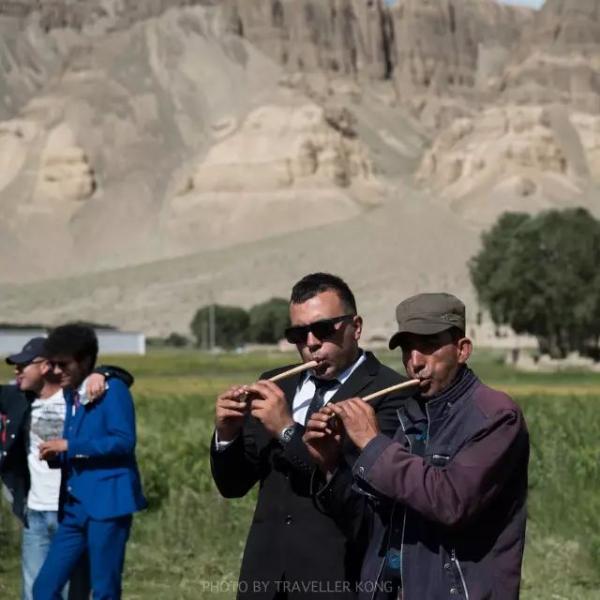
Entering the entrance of the village, the music on a small truck started to play. In Tajik music, two instruments dominated the overall situation, the eagle flute and the tambourine, both in pairs, and 4 people played. The sound of the eagle flute is very penetrating, and a long tune can resound through the valley. The tambourine beat in a low voice amidst the melodious eagle flute. The man plays the eagle flute, and the woman plays the tambourine. This natural cooperation, like the division of labor arranged since ancient times, each performs its duties seamlessly. And so it was played all the way to the bride’s house.

The bride’s home is surrounded by a field of highland barley, and the mountains of the Yardang landform in the distance stand on the roof. Under the clear sky and the sun, the singing and dancing in the yard has already been prepared. Like all people who grow up in open mountains, some talents are innate, such as dancing. Tajiks have been able to dance since they could walk.

Tajik’s eagle dance is very interesting. The man spreads his hands to imitate the wings of an eagle, raising and lowering them like an eagle soaring in the sky. Their dance is so free and seemingly random, but it makes people feel the confidence emanating from every joint. The women’s dance is simple and elegant, and there seems to be a lot of words between their brows, and every look is precisely on the node. The raised arms are waving gently, and then they stay in front of the chest and swing slowly. They dance unhurriedly, with gestures and gestures, as if telling you their whole life.
The dance between men and women is even more interesting. In addition to beauty, there is also a feeling of distance. The two sides do not touch each other, maintaining a safe and intimate distance, testing, responding, and resonating with each other. Sometimes they looked into each other’s eyes, sometimes bowed their heads shyly, and the dust they stepped on in the wide yard floated gently in the air with their dancing steps. In the air is a kind of sincerity that is directly exposed to the sun, which is the unique magnanimity of people who grew up in the alpine region and under the snow-capped mountains.

I was led into the bride’s boudoir, which made me a little thrilled. The boudoir is the innermost cabin after passing through all the rooms. It is rectangular and dimly lit. The light from the skylight shines directly on the bed. The bride is covered with a tapestry in the corner of the kang, surrounded by her sisters, and Curious children also sat on the kang and played by themselves. After a polite greeting, I was invited to sit by the bed and rest for a while.

At this time, the bride has not yet changed her clothes, and the makeup on her face has already been prepared. The bride is a typical Tajik race, with three-dimensional facial features, deep eyes, a tall nose bridge like a tall mountain on her delicate face, and her black hair is simply braided. This is a flowing river. Tell her story from childhood to adulthood. When Girls’ Generation attended other people’s weddings, did you secretly fantasize about your love and what kind of man you would marry in the future?

The sister prepared all the clothes for her, cut out a piece of cloth, wrapped it in a tray, and took it out to recite scriptures for the imam. The bride has been chatting with her girlfriends, laughing and laughing, and the tension on her face has eased a little.
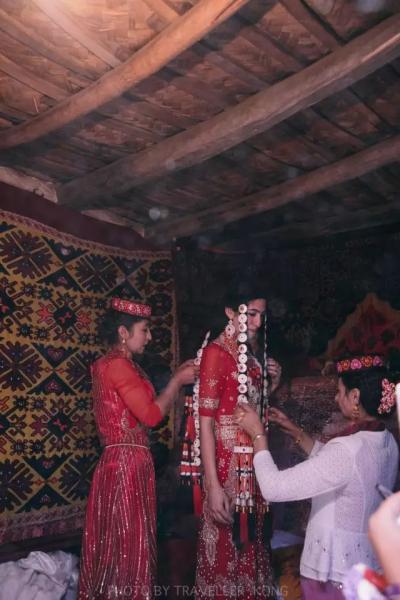
The clothes that read the scriptures can be changed for the bride, and the idlers are cleared away, leaving behind a few close girlfriends and family members.

I saw the bride wearing one piece at a time. The complicated jewelry was her declaration of happiness, and she wished there were no gaps in her body. Until the head and hands are full, you can put on the Tajik hat. Tajik hats are the most traditional decoration of Tajiks, and the hats of both men and women are flat-topped. The men’s hat is relatively simple, with a loop of wool on the bottom and a simple hook on the top. And women’s hats are much more complicated. Exquisite embroidery made by hand, even the top of the hat is full of embroidery. Tajik women are keen on embroidery. In addition to clothing, hats and jewelry, even the mattresses and pillows at home are also beautifully embroidered. Some women are born with ingenuity. But what awaited them was bitter and unpredictable.
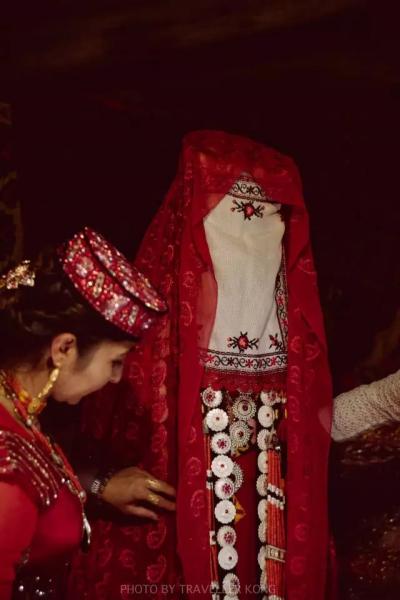
When all the decorations have been put on, they put a handkerchief over the bride’s face, behind which the elaborate attire is concealed. The bride’s well-dressed beauty is left to the groom alone.
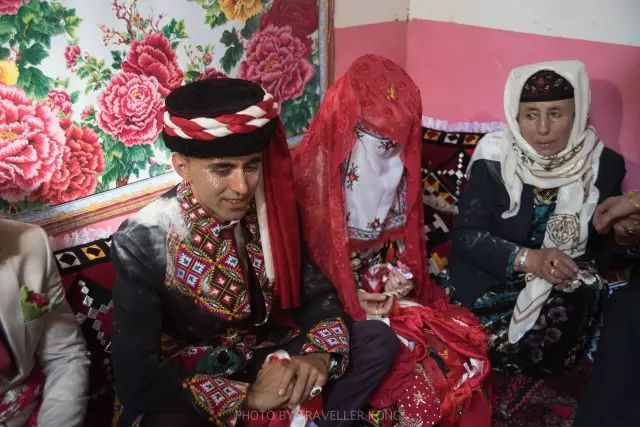
At this time, the bride and groom are about to meet, and the groom, accompanied by two best men, waits outside the boudoir. Most of the best men in Tajikistan are two people, one is young and single, and the other is older and married. When they come to the boudoir, the natal family will sprinkle flour on them, which symbolizes good luck. The bride walks out of the boudoir, accompanied by her older sisters, and hands over to the groom.
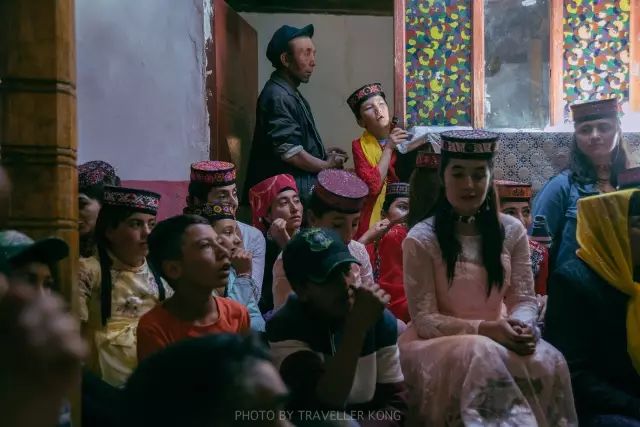
Then everyone sat down, and the bride and groom stood in the middle of the main room, facing the imam who was in charge. The imam began to read a long scripture, and everyone listened quietly. After the imam finished reading, the bride and groom sat on the kang to receive blessings and experience from the elders. Everyone hopes that the newlyweds will live in harmony and live in harmony with each other.
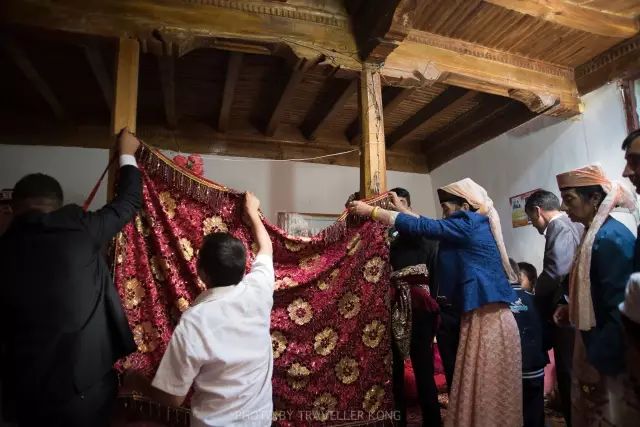
Then hang a piece of cloth on the post, which heralds the end of the ceremony, and friends and relatives can go to eat. Tajik people are warm and hospitable. Whether you are a tourist with a camera or a villager you don’t know, you will be invited into the house. After the tea is poured, I will be handed a piece of melon, and the pilaf will be served in a short while. The people in the pilaf are generally divided by one person.
Tajikistans are particular about the division of meat. Generally, boiled mutton will be divided, and everyone will have it. Sometimes they know which people are from ordinary families, and they will share more when dividing the meat. If you didn’t finish eating these people at that time, out of politeness and customs, you have to take them away when you leave.
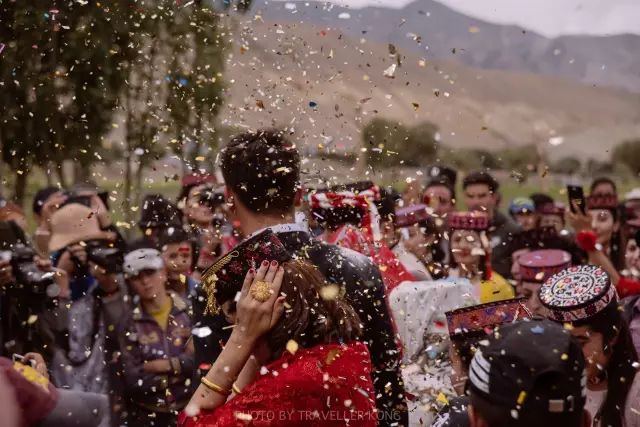
After dinner, the groom will pick up the bride. Seeing the groom walking out slowly with the bride supported, he got into the car with the blessing of his relatives. At this time, the natal family couldn’t bear it anymore, and they silently wiped away their tears. I knew that on the one hand, they were reluctant to let the bride leave home, and on the other hand, they were crying with joy. The bride was about to start another new life.
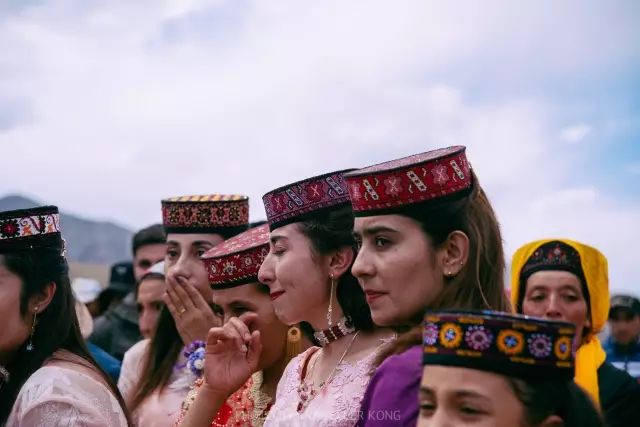
But when the car stopped a few steps away, the bride and groom got out of the car and came to a grass field where drinks and food were prepared, and some relatives and friends were cheering. It turns out that this is also a custom. When the bride leaves home, many relatives will prepare food on the side of the road to welcome her. This custom also originated from the past, when the procession of receiving relatives was picked up on horseback, the journey was far away, so relatives and friends prepared food for the procession to satisfy their hunger. Today, this custom is still continuing. Although it is no longer enough to satisfy the hunger of the bride-seeking team, it also shows that the relatives are reluctant to let the bride leave and hope that they can go home more often.
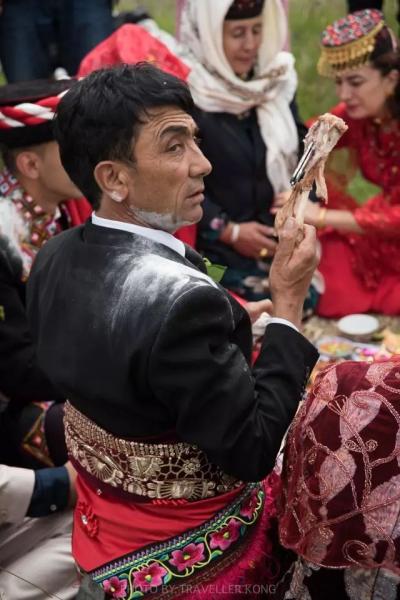
We were stopped several times along the way. It is said that once a very famous person went to Datong to pick up his relatives and was stopped dozens of times along the way. Every time besides the food, the singing and dancing are still the same. When I was moved by the happy event between heaven and earth, an uncle handed over a piece of Katraman (a kind of buttered naan). He said, eat something, don’t be hungry.
I like the mountains in Waqia Township. The weathered cross-sections are layered and carved into various shapes by the wind. A fertile small plain is surrounded by mountains. The rain is abundant, the barley and pasture are growing wildly, and there are patches of dark green fields under the earthy yellow mountains. Beautiful is probably used to describe this moment.
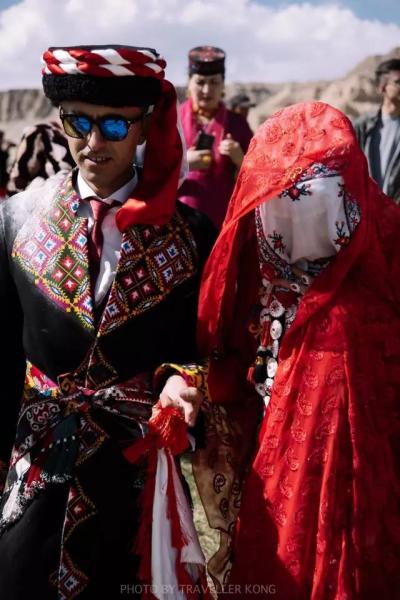
When the bride was taken back to the groom’s home, another joyful song and dance began.




